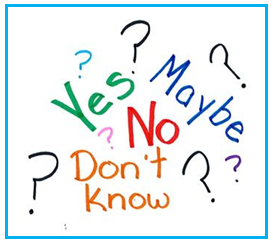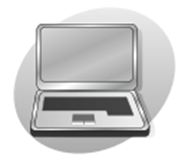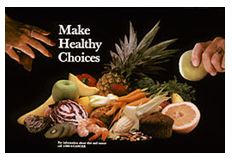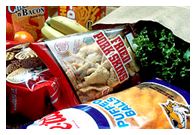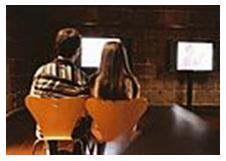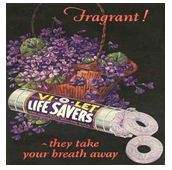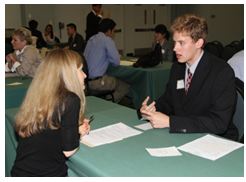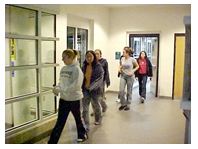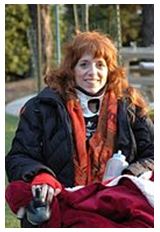High School Informational Text LASSI
BACK TO Language Arts Sample Systematic Instruction Script
Contents |
Theme: Making Choices
Grade Band: High School
Focus: Using Informational Text
| Topic | Core Content Connectors | Common Core State Standard | Essential Understanding | LASSI Objectives |
| AUTHOR'S PURPOSE | 1112.RWL.c3 Develop and explain ideas for why authors made specific word choices within text. | 11-12.RI.6 Determine an author's point of view or purpose in a text in which the rhetoric is particularly effective, analyzing how style and content contribute to the power, persuasiveness or beauty of the text. | Identify an author's point of view.
THEN
Match details to an author's point of view. |
1. Identify persuasive words the author uses and determine if the author wants you to like or dislike. |
| COMPREHENSION | 1112.RI.b1 Use two or more pieces of evidence to support inferences, conclusions, or summaries of text.
|
11-12.RI.1 Cite strong and thorough textual evidence to support analysis of what the text says explicitly as well as inferences drawn from the text, including determining where the text leaves matters uncertain. | Make an inference from an informational text.
THEN
Identify a conclusion from an informational text. THEN
Identify a summary from an informational text. THEN
Identify details to support the inference, conclusion, or summary. |
2. Select an inference, conclusion, or summary statement using 2 or more details from a high school informational text (how do you know). |
| AUTHOR'S POINT OF VIEW | 1112.RI.d1 Determine the author's point of view or purpose in a text. | 11-12.RI.6 Determine an author's point of view or purpose in a text in which the rhetoric is particularly effective, analyzing how style and content contribute to the power, persuasiveness or beauty of the text. | Identify what an author tells about a topic.
THEN
Identify the author's opinion about the topic. |
3. Determine the author's purpose or point of view. |
| ANSWERING QUESTIONS | 1112.RI.e1 Integrate and evaluate multiple sources of information presented in different media or formats (e.g., visually, quantitatively) as well as in words in order to address a question or solve a problem.
|
11-12.RI.7 Integrate and evaluate multiple sources of information presented in different media or formats (e.g., visually, quantitatively) as well as in words in order to address a question or solve a problem. | Locate information within a text related to a given topic.
THEN Determine the usefulness of the information for a given topic.
|
4. Pose a question, use KWHL with 2 or more sources (internet is one). |
| Be sure to provide specific practice to students on the skills that correspond to their grade level. | ||||
Materials Needed: Print the article summaries, table, and graphic organizers provided. Print, cut, and laminate (if desired) response boards and response options found at the end of this lesson. We recommend that every student be given a copy of the article summaries, the table, and graphic organizers. Note that the article summaries are written in Level 3 text (no picture icons; the Lexile level of the summarized text is about half the grade-level text). See notes on "Build Towards Grade Level Competence" for moving students towards grade-level text (Level 4). Teachers may modify the articles by adding the vocabulary picture icons, simplifying sentences, and deleting nonessential sentences (Level 2 text). We have also provided a Level 2 text example in the "Build Towards Independent Reading" section. The repeated story line is written simply (Level 1 text) and can be emphasized for students with emergent literacy (e.g., "We need your help.") For students with the most significant or multiple disabilities, objects can be used to augment the story (e.g., objects to represent home, school, work, and friends).
BUILD ESSENTIAL UNDERSTANDING(See teacher materials for article summaries, the table, and response options.)
BUILD A GRADE-ALIGNED COMPONENT: II. PASSAGE COMPREHENSION
| Step | Teacher Says/Does | Student Response |
| 11. | Give students a copy of article #1 – Teens Make Good Volunteers. Where is the title of the article? (Note: teachers may choose to skip this step in future lessons.) Teacher reads title. The title of our first article is "Teens Make Good Volunteers." |  Points to title at the top of the page. If student needs help, use LIP. Points to title at the top of the page. If student needs help, use LIP.
REMEMBER TO PRAISE EACH CORRECT RESPONSE! |
| 12. | One of the decisions you may make is whether to volunteer in your community. Volunteers are people who offer to help others, usually by performing a job. There are many jobs that you could choose from. For example, animal shelters need people to care for the animals. Give other examples based on what you know your students are interested in. Volunteer jobs are very important. Let's read an article about teen volunteers. I need your help reading the article. When I read, "Volunteering is important work", I want you to help me read "important work!" (Hold up a sentence strip with the words "Volunteering is important work!" Point to the words as you read them, but wait for student to read the underlined words. Let's practice. "Volunteering is important work!" Read article #1 – Teen Make Good Volunteers. | Reads "important work." (e.g., student may use voice output device to say "important work" or speak the words to help read it). |
| READ ADAPTED TEXT: Read article #1 – Teens Make Good Volunteers. Some students may be able to read this passage aloud independently. | ||
| READER OPTION: Use the sight words as the response options.
LISTENER OPTION: Use the pictures as the response options. | ||
| 11th Objectives: Identify persuasive words the author uses and determine if the author wants you to like or dislike. Use article #1 – Teens Make Good Volunteers and Persuasive Writing graphic organizer. | ||
| Step | Teacher Says/Does | Student Response |
| 13. | Authors have a reason or purpose for writing. They want to tell you about their view on a topic. This is known as author's point of view. We are going to use a graphic organizer to help us to find the author's point of view in this article. Give each student a persuasive writing graphic organizer. First, let's put the topic on the chart. Point to the word "topic" at the top of the graphic organizer. The topic is what the article is about. Here are four possible topics. Read each of the four possible topics.
- teens play sports - parents of teens - teens make good volunteers - teens are busy people What is the topic of this article? Assist students as needed to affix or write the topic on the graphic organizer. |
 Selects "teens make good volunteers" from the response options or points to the title of the article. If student does not select/point to "teens make good volunteers", use LIP and point to the words in the title. Selects "teens make good volunteers" from the response options or points to the title of the article. If student does not select/point to "teens make good volunteers", use LIP and point to the words in the title.
Affixes the correct response option or writes the words on the graphic organizer. Hint: If students need help, remind them that the title often says what the article is about. Also, point out that the first sentence of the article often says what the article is about. |
| 14. | The author has three facts to support the purpose or reasons for writing this article. In this article, the author describes one reason in each paragraph. Point to each paragraph in the article. The author also uses a signal word in each paragraph to let you know a reason is coming up. The signal words are "first", "next", and "last." I'm going to read the 1st paragraph again. Listen for a reason. The sentence will start with the word "first." Reread the 1st paragraph. What is the first reason the author states that teens make good volunteers?
- First, there are a large number of teens who can volunteer. - Nearly 60% of teens aged 12-17 years volunteer. - In addition, girls are more likely to volunteer than boys. - Teens make good volunteers for three reasons. Assist students as needed to affix the reason in the "reason 1" box of the graphic organizer. |
Points to the correct sentence strip from options or reads/points to the correct sentence in the 1st paragraph (i.e., "First, there are a large number of teens who can volunteer."). If more help is needed, limit the number of options students select from 4 to 3 options.
Options: For this part of the lesson, students can indicate the reason by underlining or highlighting it. Affixes the reason in the "reason 1" box of the graphic organizer. |
| 15. | What signal word tells you a fact is coming?
Let's put the signal word on the graphic organizer. Assist students as needed to affix the signal word on the graphic organizer. |
Selects "first" from options or reads/points to the word "first" in the article.
Affixes the signal word "first" on the graphic organizer. |
| 16. | Another fact to support the purpose or reason the author wrote this article is in the 2nd paragraph. The sentence starts with the word "next." I'm going to read the 2nd paragraph again. Listen for the sentence that starts with the word "next." Reread the 2nd paragraph. What is the next fact to support the purpose or reason the author states that teens make good volunteers?
- Teens are busy people. - In addition, they spend 1-2 hours each time they volunteer. - Next, teens have time to volunteer. - Teens volunteer once or twice a month. Assist students as needed to affix the reason in the "reason 2" box of the graphic organizer. |
Points to the correct sentence strip from options or reads/points to the correct sentence in the 2nd paragraph (i.e., "Next, teens have time to volunteer.") If more help is needed, limit the number of options students select from 4 to 3 options.
Affixes the reason in the "reason 2" box of the graphic organizer. |
| 17. | What signal word tells you a fact to support the purpose or reason is coming?
Let's put the signal word on the graphic organizer. Assist students as needed to affix the signal word on the graphic organizer. |
Selects "next" from options or reads/points to the word "next" in the article.
Affixes the signal word "next" on the graphic organizer. |
| 18. | You have found 2 facts to support the purpose or reasons. Let's find the last fact to support the purpose or reason. It is in the 3rd paragraph. Point to the 3rd paragraph. The sentence starts with the word "last." I'm going to read the 3rd paragraph again. Listen for the sentence that starts with the word "last." Reread the 3rd paragraph. What is the last fact to support the purpose or reason the author states that teens make good volunteers?
- Most parents of teen volunteers said they have volunteered in the past year. - In addition, teens get their friends to volunteer. - Last, teens influence other people to volunteer. - When asked, 80% of teens said their friends volunteered as well. Assist students as needed to affix the reason in the "reason 3" box of the graphic organizer. |
Points to the correct sentence strip from options or reads/points to the correct sentence in the 3rd paragraph (i.e., "Last, teens influence other people to volunteer.") If more help is needed, limit the number of options students select from 4 to 3 options.
Affixes the reason in the "reason 3" box of the graphic organizer. |
| 19. | What signal word tells you a fact to support the purpose or reason is coming?
Let's put the signal word on the graphic organizer. Assist students as needed to affix the signal word on the graphic organizer. |
Selects "last" from options or reads/points to the word "last" in the article.
Affixes the signal word "last" on the graphic organizer. |
| 20. | Let's review our graphic organizer together. Point to the topic, reasons, and signal words as you read them. The author chooses words to persuade you. The author wants you to agree with his or her point of view. In this case, the author uses the words "first, next, and last" to list three facts to support the purpose or reasons that teens make good volunteers. Does the author want you to agree with them or disagree with them? | Selects "agree" from the response options.
Hint: If more help is needed, explain that the author is giving reasons for believing that teens make good volunteers. |
| 21. | This author also uses other words to persuade you to agree. Listen as I read a sentence from each paragraph and see if you hear the same phrase in each of the sentences. Read the sentences.
- In addition, girls are more likely to volunteer than boys, but just by a little. - In addition, they spend 1-2 hours each time they volunteer. - In addition, teens get their friends to volunteer. What phrase did you hear in each of the sentences? That's right. The author uses the phrase "in addition" to give you a fact that supports each of their reasons. Assist students as needed to affix the persuasive words on the graphic organizer. |
Selects "In addition" from the response options or points to the words on the sentence strips.
Hint: If students need more help, point to the words "in addition" or highlight the words in the article. Affixes the persuasive words "in addition" on the graphic organizer. |
| 11th Objective: Determine the author's purpose or point of view. Use article #2 – Teens and the Media and Author's Purpose graphic organizer. | ||
| Step | Teacher Says/Does | Student Response |
| 22. | I am going to read another article. The topic of this article is teens and the media. Remember, the topic is what the article is about. Give each student a copy of article #2 – Teens and the Media. I need your help reading the article. When I read, "The media influences what we buy", I want you to help me read "what we buy." (Hold up a sentence strip with the words "The media influences what we buy." Point to the words as you read them, but wait for student to read the underlined words. Let's practice. "The media influences what we buy." Read article #2 – Teens and the Media. Some students may be able to read this passage aloud independently. | Reads "what we buy." (e.g., student may use voice output device to say "what we buy" or speak the words to help read it). |
| 23. | Give each student the author's purpose graphic organizer. Authors have a purpose for writing. The author's purpose can be to entertain us (just for fun)…point to the "entertain" column on the graphic organizer, to persuade us (convince us of something)… point to the "persuade" column on the graphic organizer, or to inform us (give us facts)…point to the "inform" column on the graphic organizer. I'm going to read a sentence from the article and you decide which column it goes in. Here's the first sentence. "Teens watch 40,000 ads a year through television alone." What is the purpose of this sentence?
Let's put the sentence in the "inform" category? Assist students as needed to affix the sentence on the graphic organizer. |
Selects "inform" from response options or points to "inform" column on the graphic organizer.
Hint: If students need more help, remind them that when the author's purpose is to inform us, they will tell us facts and reasons. Affixes the response option on the graphic organizer or writes the sentence under the "inform" column. |
| 24. | Let's try another sentence. "These ads affect the food and beverage choices teens make." What is the author's purpose?
Assist students as needed to affix the sentence on the graphic organizer. |
Selects "inform" from response options or points to the "inform" column on the graphic organizer.
Affixes the response option on the graphic organizer or writes the sentence under the "inform" column. |
| 25. | Here's one more. Listen as I read this sentence aloud. "Parents have the greatest influence over whether teens eat healthy foods." What is the author's purpose?
Assist students as needed to affix the sentence on the graphic organizer. |
Selects "inform" from response options or points to the "inform" column on the graphic organizer.
Affixes the response option on the graphic organizer or writes the sentence under the "inform" column. |
| 26. | Let's look at the graphic organizer. Read graphic organizer with students. All of the sentences are in the "inform" column. What is the author's purpose?
Yes, the purpose is to inform the reader about a topic. What was the topic of this article? That's right! The purpose of this article is to inform the reader about teens and media. |
Selects "inform" from response options or points to the "inform" column on the graphic organizer.
Selects "teens and media" from response options. |
| 11th Objective: Pose a question and use a KWHL chart to find the answer using two or more sources (internet is one). Use article #3 – Tips for a Successful Job Interview and KWHL graphic organizer. | ||
| 27. | Give each student a copy of article #3 – Tips for a Successful Job Interview. Some of you may want to get a job. Many times, when you are trying to get a job, you will have an interview. Next, we are going to learn some tips for a successful job interview. Point to each tip as I read them. Read article #3 – Tips for a Successful Job Interview. Some students may be able to read this passage aloud independently.
Assist students as needed to point to each tip as you read it. (Note: there is no repeated story line for this article.) |
Points to each tip as the teacher reads it. |
| 28. | We are going to use the KWHL Chart to help us with this part of the lesson. Give each student a KWHL chart. What is the topic of this article?
Let's put the topic on our KWHL chart. Assist students as needed to affix the response option "job interview" or write the words "job interview" in the topic line on the KWHL chart. |
 Selects "job interview" from response options. Selects "job interview" from response options.
If student does not select/point to "job interview", use LIP and point to the words in the title.
|
| 29. | The KWHL chart can help us organize what we know and what we want to learn about a topic. In the first column, we write/record what we know about job interviews. Point to the first column of the KWHL chart. What do you know about job interviews?
Option: Teachers may do this activity with the whole class or with smaller groups of students. Teachers may want to put a large KWHL chart on the board to record students' responses as the lesson progresses. Students can also complete individual KWHL charts by affixing response options or writing their responses on the chart. Assist students as needed in affixing their responses on the KWHL chart. |
Selects or otherwise communicates some things they know about job interviews. Some response options are provided, but students may think of other responses that are not included. Accept all logical answers that have to do with job interviews.
The response options included are: "get a job" "answer questions" Affixes responses in the K column on the KWHL chart. |
| 30. | In the second column, we write/record the things we want to learn about job interview. What are some things you want to learn about job interviews?
Assist students as needed in affixing their responses on the KWHL chart. |
Selects or otherwise communicates that they want to learn more about "what to wear to an interview." Other responses are acceptable and should be recorded, but the rest of the lesson is based on learning more about what to wear to an interview.
Affixes responses in the W column on the KWHL chart. |
| 31. | The third column on the KWHL chart is where we list some ideas for how we can learn more about what we want to know. What are some ways we can learns more about what we want to know?
If needed, assist students in affixing their responses on the KWHL chart. |
Selects or otherwise communicates one or more of the following possible sources of information: internet, books, videos, people, and library.
The response options included are: internet, books, videos, people, and library. Affixes responses in the H column on the KWHL chart. |
| 32. | One of the things you said you wanted to learn more about is what to wear to a job interview. Point to "what to wear" on the KWHL chart. The internet is one of the ways you can learn more about what to wear to a job interview. Let's visit a website that has some pictures of clothes that are appropriate to wear for a job interview. Assist the students in opening the following link into a new web browser tab/window: http://jobsearch.about.com/od/teenstudentgrad/ig/Interview-Attire/
Click on "Enter Gallery" to see the pictures. Students use the "next" and "previous" buttons to go forward and backward. We can write/record what we learned about the right clothes to wear to an interview in the L column of the KWHL chart. Point to the L column. What is one thing that is appropriate for a girl to wear to an interview? If needed, assist students in affixing their responses on the KWHL chart. |
 Selects "sweater" from response options. If more help is needed, use LIP. Selects "sweater" from response options. If more help is needed, use LIP.
Affixes the response to the L column of the KWHL chart. |
| 33. | What is one thing that is appropriate for a boy to wear to an interview?
If needed, assist students in affixing their responses on the KWHL chart. |
 Selects "shirt and tie" from response options. If more help is needed, use LIP. Selects "shirt and tie" from response options. If more help is needed, use LIP.
Affixes the response to the L column of the KWHL chart. |
| 34. | Let's look at the website for examples of what NOT to wear to a job interview. Assist students in finding the following webpage: http://jobsearch.about.com/od/interviewattire/ig/What-Not-to-Wear---Teens/What-Not-to-Wear---Teens.-5EK.htm
Students use the "next" and "previous" buttons to go forward and backward. What is one thing a girl should NOT wear to an interview? If needed, assist students in affixing their responses on the KWHL chart. |
 Selects "teeshirt" from response options. If more help is needed, use LIP. Selects "teeshirt" from response options. If more help is needed, use LIP.
Affixes the response to the L column of the KWHL chart. |
| 35. | What is one thing a boy should NOT wear to an interview?
If needed, assist students in affixing their responses on the KWHL chart. Be sure to complete all of the steps of the KWHL chart and end with a review of what was Learned. |
 Selects "ball cap" from response options. If more help is needed, use LIP. Selects "ball cap" from response options. If more help is needed, use LIP.
Affixes the response to the L column of the KWHL chart. |
| 11thObjective: Select an inference, conclusion, or summary statement using two or more details from a high school information text. Use article #4 – Teens and Part-time Employment | ||
| Step | Teacher Says/Does | Student Response |
| 36. | Give students a copy of article #4 – Teens and Part-time Employment. Some of you may want to get a job while you are in high school and after you graduate. Next, we are going to talk about some of the benefits and drawbacks to working part-time. Read article #4 - Teens and Part-time Employment aloud to students. NOTE: There is not a repeated story line for this article. Where is the title of the article?
You're right. The title of this article is "Teens and Part-time Employment." |
 Points to title of the article. If more help is needed, use LIP. Points to title of the article. If more help is needed, use LIP.
|
| 37. | What is the topic of this article? If help is needed, reread the title again. | Selects "teens and work" from response options. If more help is needed, use LIP. |
| 38. | What does the author talk about in the 2nd paragraph? Point to the 2nd paragraph. If more help is needed, reread the 1st sentence of the 2nd paragraph. |  Selects "benefits" from response options. If more help is needed, use LIP. Selects "benefits" from response options. If more help is needed, use LIP.
|
| 39. | What does the author talk about in the 3rd paragraph? Point to the 3rd paragraph. If more help is needed, reread the 1st sentence of the 3rd paragraph. |  Selects "drawbacks" from response options. If more help is needed, use LIP. Selects "drawbacks" from response options. If more help is needed, use LIP.
|
| 40. | What does the author say is the reason for the difference?
Point to the 4th paragraph. If more help is needed, reread the 1st sentence of the 4th paragraph. |
 Selects "number of hours worked" from response options. If more help is needed, use LIP. Selects "number of hours worked" from response options. If more help is needed, use LIP.
|
| 41. | What does the author conclude is a good alternative for teens in the 5th paragraph? Point to the 5th paragraph. If more help is needed, reread the 1st sentence of the 5th paragraph. |  Selects "summer employment" from response options. If more help is needed, use LIP. Selects "summer employment" from response options. If more help is needed, use LIP.
|
| 42. | What is the first reason that summer employment is a good alternative? If more help is needed, reread the 2nd sentence of the 5th paragraph. Have students find the word "first." |  Selects "doesn't interfere with school" from response options. If more help is needed, use LIP. Selects "doesn't interfere with school" from response options. If more help is needed, use LIP.
|
| 43. | What is the second reason that summer employment is a good alternative? If more help is needed, reread the 3rd sentence of the 5th paragraph. Have students find the word "next." |  Selects "free time" from response options. If more help is needed, use LIP. Selects "free time" from response options. If more help is needed, use LIP.
|
| 44. | What is the third reason that summer employment is a good alternative? If more help is needed, reread the 3rd sentence of the 5th paragraph. Have students find the word "last." |  Selects "benefits without drawbacks" from response options. Selects "benefits without drawbacks" from response options.
|
| We are finished reading about making choice. Thank you for reading with me today. | ||
ADDITIONAL TEXTS TO EXTEND AND ENRICH THE LESSON
Choose additional texts to extend and enrich the lesson from grade-level texts and online resources. Some online resources to consider include:
College Bound
- Virginia's College Guide for Students With Disabilities http://www.doe.virginia.gov/special_ed/transition_svcs/outcomes_project/college_guide.pdf
- Students with Disabilities Preparing for Postsecondary Education: Know Your Rights and Responsibilities http://www2.ed.gov/about/offices/list/ocr/transition.html
Volunteer Work
- To look for organizations to volunteer with in your area check with your local United Way at: www.unitedway.org
- Look at the Youth Volunteer Corps of America, for volunteer opportunities: www.yvca.org
- An article about teenagers and volunteering: http://philanthropy.com/article/Half-of-American-Teenagers/135278/
The Influence of the Media
- The Merchants of Cool (Frontline PBS, PDF is available for teachers): http://www.pbs.org/wgbh/pages/frontline/shows/cool/
Paid Employment
- Helping Students with Cognitive Disabilities Get a Job: http://nichcy.org/wp-content/uploads/docs/ta3.pdf
- Preparing Students with Disabilities for School-to-Work Transition and Postschool Life: Planning WEB.pdf http://www.nasponline.org/resources/principals/Transition%20Planning%20WEB.pdf
*NOTE TO TEACHER: Repeat the lesson using articles and other informational texts found in grade-level textbooks and from online resources.
When selecting articles:
- Select an age-appropriate informational text.
- Summarize the text (e.g., 700 - 900L).
- Identify important key vocabulary.
- Include graphs, tables, charts, etc.
- Include a variety of text structures (e.g., sequence/process; events/enumeration/description; compare-contrast).
- Include articles with a variety of purposes (i.e., inform, persuade, entertain).
- Use graphic organizers to help students compare/contrast, identify main idea/topic, and retell key details.
- Ask a variety of questions, including "wh" questions that are found on the page (i.e., factual recall) and from you head (i.e., inferential).
- Develop response options for receptive responding.
- Have fun!
BUILD TOWARDS GRADE-LEVEL COMPETENCE (Level 4 Text)
See ADDITIONAL TEXTS TO EXTEND AND ENRICH THE LESSON for Level 4 texts to use to build towards grade-level competence.
BUILD TOWARDS INDEPENDENT READING (Level 2 text)
| READER OPTION (this step is optional for students who are learning to read independently): Before we read the article, let's try to read some words from the article. Sometimes we can read a new word by sounding out the letters. Let's try a few. I'll show you a word. Read it and show me the picture. (You may substitute words and pictures related to phonics skills your students are learning). | ||
| Step | Teacher shows each word (do not read it) | Student Response |
| 1. | teen | Reads "teen." Points to teen. (If student needs help on these words, show how to sound it out /t/ /e/ /e/ /n/.) |
| 2. | help | Reads "help." Points to help. |
| 3. | name | Reads "name." Points to name. |
| 4. | joy | Reads "joy." Points to picture of joy. |
| 5. | hope | Reads "hope." Points to picture of emotion/hope. |
| Have the student read the text aloud (or silently) and then answer each comprehension question. | ||
| Level 2 Article – I am a Teen Volunteer
Hi. My name is Hamza. I am a teen. I want to be a volunteer. But I am afraid I cannot because I have a disability. I do not want to mess up. I decide to try it anyway. I like to help people. I found out I can do a lot of things. I have a lot to offer. It makes me feel good to volunteer. I have been serving my community ever since. I hope the things I have learned can help you. Being a volunteer is important. Volunteers help make communities better. Good luck! I hope volunteering brings joy to you and others. |
Comprehension Questions:
What did Hamza want to be? (a volunteer) Why did Hamza think she could not volunteer? (she has a disability) How does Hamza feel when she volunteers? (good) Why does Hamza think being a volunteer is important? (make communities better) | |
| GENERALIZATION ACROSS MATERIALS - Repeat this lesson using the article "Have a Great Freshman Year" | ||
| Article | "Wh" questions | Determine Author's Purpose |
| Read "Have a Great Freshman Year" | What is the title of the article? (How to Have a Great Freshman Year)
How does the author organize the article? (Tip #1, etc.) What does the author conclude all freshman students want? (friends) What does the author recommend new students do to have a great year? (get involved) |
Use the Author's Purpose graphic organizer to determine the purpose the author has for writing the article. Place the following sentences in the correct column (i.e., inform, persuade, entertain).
- I am sharing what I learned my freshman year so that you can have a great freshman year, too. - It is very important to meet with the Head of Safety to come up with a plan in case of fire or drills, tornado, or medical issues. - It is important for people to get to know you because one day you may need to ask them for assistance or support. - Meet with your professors by yourself so they can get to know you. |
| REAL LIFE READING. After completing the lesson, send a copy of each article and a list of comprehension questions with a response board home for homework practice. Bring a copy of a local newspaper to class and have students read the titles and look at the pictures. Incorporate the use of graphs, maps, and charts into daily instruction. Also, bring into the classroom various job applications to discuss and complete. Find on-line job applications on the Internet and compare the differences between written and online applications. | ||
Printable Materials
Image Attributions
Image attributions for images found in the supplemental materials resources. Note the Skills Test has its own attributions page included in the pdf.
